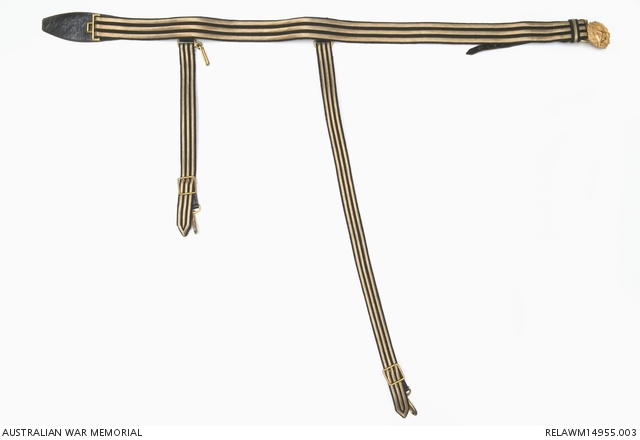| Places | |
|---|---|
| Accession Number | RELAWM14955.003 |
| Collection type | Heraldry |
| Object type | Personal Equipment |
| Physical description | Leather; Silk; Gold bullion thread; Gilded brass |
| Maker |
Moore, Scantlebury & Coote |
| Place made | United Kingdom |
| Date made | c 1911 |
| Conflict |
Period 1920-1929 First World War, 1914-1918 |
Full dress sword belt : Captain J C T Glossop, Royal Navy


Captain's full dress sword belt. Black leather belt, 40 mm wide, has two slings 25 mm wide. All are covered with black silk webbing and are embroidered with three gold bullion thread stripes. The buckles and hooks are gilded brass, as is the circular clasp, which has embossed laurel leaf edges and an anchor and king's crown in the centre. The clasp is impressed inside 'S.S.'. The free end of the belt is stamped inside with gold lettering 'MOORE, SCANTLEBURY & COOTE NAVAL OUTFITTERS "THE HARD" PORTSEA, & 47. CONDUIT STREET LONDON. W.'. A narrow leather strap and gilt buckle on the inside of the belt allows the length of the belt to be adjusted at the clasp end.
Worn by Captain John Collings Taswell Glossop, Royal Navy. Born in England in 1871, Glossop served as a midshipmen in Samoan waters in the corvette HMS Calliope, and as a lieutenent in the corvette HMS Royalist during the 'Samoan troubles; of 1899. His later service included a posting as commander in the battleship HMS Hood. In June 1911 Glossop was promoted to captain and on 26 June 1913 was lent to the Royal Australian Navy and appointed to command the newly commissioned Chatham class light cruiser HMAS Sydney. During the First World War the Sydney, under Glossop's command, defeated and beached the German raider SMS Emden off the Cocos-Keeling Islands on 9 November 1914. In 1915 the Sydney was sent to protect British colonies in the West Indies and in 1916 transferred to the North Sea patrolling to intercept German merchant shipping and submarines. Glossop left the ship in the middle of 1917. He was promoted to Rear Admiral in 1921 shortly before being placed on the retired list, and to Vice Admiral in 1926. He died in 1934.